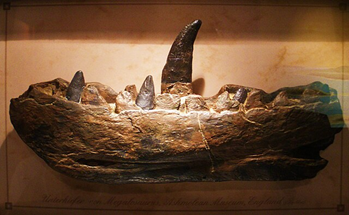What’s the deal with May Morning in Oxford?
Founded in 1485 by William Wayneflete, Bishop of Winchester and Lord Chancellor of England, it is not surprising to find that Magdalen College is steeped in stories and age-old traditions. Very few still believe that it was founded by Adam but the Old Library does have one of the earliest extracts of the Gospel of St Matthew; Cardinal Wolsey was its Bursar and C. S. Lewis an undergraduate and later a Tutorial Fellow. It should come as no surprise, therefore, that May Morning celebrations have a religious background.
Origins
They are derived from an obligation imposed in 1484 on the Rector of St John the Evangelist, Slimbridge in Gloucestershire for an obit (requiem mass) to be sung for the soul of Lord Berkeley (1437- 1484) of Berkeley Castle. £10 was provided annually to provide for the ceremony. When Henry VII (1457-1509) came to the throne he benefited from a dispute between Lord Berkeley and his brother in that he dubiously acquired the advowson (right to appoint a priest) of Slimbridge. However, the king the granted a licence to Magdalen permitting the college to retain the advowson (the right of the patron to put forward a member of the clergy) and the £10 per annum in tithes, which were used to fund the first May Morning .
Although it has been said that the ceremony has existed for over 500 years, very little is known definitely about its early days. An early allusion to May morning was made in 1674 by Anthony Wood, antiquary (1632-1695) to, “an ancient custom involving saluting Flora with vocal music in several parts” which was said to have given “great content to the neighbourhood and auditors underneath.” In 1688 due to the Great Controversy (sic) with James II there was no ceremony because of a “want of chorister and clerks”. An account of May Morning in 1749 by another antiquarian, John Pointer (1688-1754) gives more information:
Another remarkable Custom is their having a Concert of Music on the top of the tower every May Day at 4 o’Clock in the Morning in commemoration of k. Henry VII … being a Mass of requiem. But now it is merry Concert of both Vocal and Instrumental Music, consisting of several merry Ketches (catches) and lasting for 2 hours ending with the ringing of the bells.
The fact that the college, stood aloof from the town in its own deer park, may explain why it did not seem to decline into the feasting and roistering of the university in 1700s: its Calendar records only four occasions of celebration, one of which was May Morning. However, the Calendar does not cover the private life of the students.
The Victorian age
The college was most fortunate that to have as Fellow from 1835-63 John Rous Bloxham, one of the few at that time dedicated to Magdalen’s choral traditions. A member of the Tractarian (High Church) movement, he was passionate about religious ritual and the beauty of holiness. He also greatly enjoyed music, attending concerts of all kinds from oratorios to the singing of glees. He helped to make the Choir an essential part of the college by reviving and (re)inventing college traditions, in particular the singing of the Eucharistic hymn, Te Deum Patrem Colimus (Of thee O God the Father – thee/All worthy praise and Glory be) on May Morning. The words were by Dr Thomas Smith, Fellow in Music (1666- 1692) and the music by Benjamin Rogers, Organist (1665-1668). Rogers was unpopular not least for talking loudly in the organ loft during services. However, the strains of his hymn on May Morning haunt the brain long after the Morris dancers have packed away their sticks and all the full English breakfasts have been cleared away. The hymn is still used regularly as a Grace. However, Bloxham’s letter to a friend 1869 reveals how irreverently it had once been sung,
More like a Bacchanalian than a Sacred Song. The choirmen and choristers assembled on the Tower in their usual garb and kept their hats and caps on during the singing. The principal function of the choristers seemed to be to throw down rotten eggs on the crowd below the Tower. Old Mundy, the principal Porter, tried to check this by standing at the bottom of the Tower staircase and tapping with the Tower key the pockets of the choristers as they passed him.
In 1844 the Rules were revised: choristers were to wear surplices, the only music was to be the Eucharistic hymn, heads were to be uncovered during its singing and the choir was to face east. It is this version of May Morning which inspired William Holman Hunt’s painting (see above), which can be seen in the Lady Lever Art Gallery, Liverpool, and it continues to the present day. By the end of the 1860s May Morning had become a notable social event for old members. Prince Hassan of Egypt attended in 1872 and Queen Victoria’s son, Prince Leopold in 1872. Tickets had to be introduced to limit the numbers. Even so, there were at least 200 on the Tower in 1969, including some ladies.
20th century changes
Bloxham’s instruction that only the Eucharistic hymn was sung on May Morning lasted until 1922 when Haldane Campbell Stewart (organist and choirmaster 1919-42) introduced the additional singing of a Vaughan Williams May Day Carol to the repertoire. Soon followed madrigals such as ‘Now is the Month of Maying’, ‘It Was a Lover and His Lass’, ‘The Silver Swan’, and there were Jack-in-the-Greens, children wearing garlands and decorated horse-drawn carts in the streets. An even great shock to some, but fitting to others, came on May Morning 1959 when, in the presence of A.J.P. Taylor, Fellow of Magdalen and CND (Campaign for Nuclear Disarmament) activist standing in for the President, a woman tossed hundreds of anti-nuclear pamphlets from the tower. Also during these unquiet times, a student involved in the low key revolt of at the end of Trinity term 1968 had earlier tried to drown down the May Morning singing with a relaying by loudspeakers of the Red Flag.
The social upheavals of the 60s led to Oxbridge colleges being seen as bastions of privilege. As John Stoye, Fellow in History (1948-84) put it, “Magdalen is, let it be said, an entity of remarkable fascination, a bit of a basilisk.” As one of its more iconic institutions, May Morning attracted more fascination than most, not all of which was good. According to a person unknown, “Of all the many jokes Oxford makes on us, May Morning must be the silliest. There we all were crammed onto Magdalen Bridge as if it were Live Aid (charitable fundraiser begun by Bob Geldof, lead singer of the rock band Boomtown Rats) all over again.”
To college members, however, May Morning was a highlight of Trinity term, given an addition elegance by the presence of dancers in white-tie and tails fresh (if sometimes tipsy) from the previous evening’s ball at Shotover Park, associated with the college from Reformation times by suppling hay for the stables. Gradually the non-religious elements began to take over and spread across the city: the ringing of the bells was joined by the sounds of jazz, bands and barber shop quartets; Morris dancers sturdily clashed their sticks; Scots in kilts pirouetted over crossed swords; there were jugglers and Punch and Judy.
Much worse was the rowdiness outside the college which was beyond its control. The academic pressures of modern university life may have played a part in bringing about more sedate celebrations but they still had their moments. About 25 years ago, I watched my first May Morning from Daubeny Buildings in the Botanical gardens which had a direct view of the bridge. The sun shone, little girls in bonnets decorated with flowers (later discovered to have been planted by a tabloid newspaper) were in evidence and the parade of jumpers endless. The gift of a bottle of champagne for each jump by the same paper may have been the cause. The music was heavenly and everything joyous. On a later occasion a young woman jumped in the river stark naked. After it was discovered she was a vicar’s daughter, she appeared in a tabloid photograph wearing only some suitably draped bluebells.
Swan Song
In 1997 a student broke his spine and became paralysed after jumping into the river. As a result, the bridge was closed to pedestrians on future May Morning and patrolled by police. Covid caused a disruption to the celebrations, but Floreat Magdalena and May Morning persevered through online celebrations for the enjoyment of both Town and Gown.
Written by volunteer Jane Allingham.
Want to write your own Oxford-inspired post? Sign up as a volunteer blogger.



